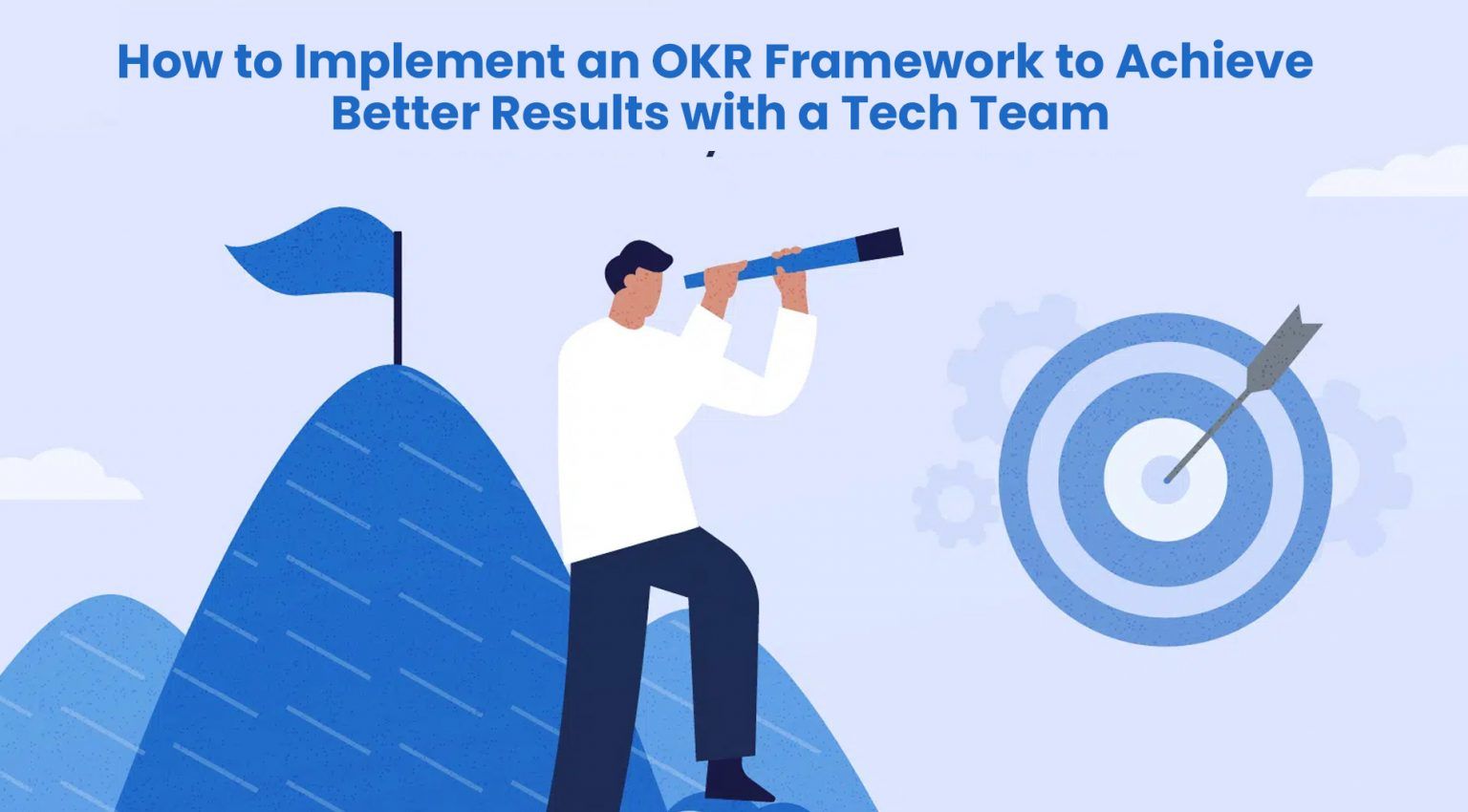Connect with OneDrive
High Quality Video Sharing
Store & share your recordings seamlessly with OneDrive integration
8 min to read
Objectives and Key Results (OKRs) have continuously played a significant role in business management. Everyone from Deloitte to Spotify uses them to improve performance. And we are here to give you a Guide On how to Implement OKR Framework.
Setting and achieving goals is an important part of any business, and it can be especially difficult when you have a remote tech team.
Whether you’re a CEO, manager, or individual contributor, Implementing an OKR framework can help you achieve better results. OKRs (Objectives and Key Results) are a simple yet powerful way to keep everyone aligned and on track while still allowing for flexibility.

They can be adapted to any company size or industry, and they work great for both short-term and long-term projects. Despite seeming like a recent phenomenon, they have been around for more than half a century. Evolved from similar ideologies, OKRs effectively lay out the groundwork for companies to measure their growth and success.
If you’re looking to increase the effectiveness of your tech team, you may want to consider Implementing an OKR framework. OKRs (objectives and key results) are a performance management system that provides a framework for setting measurable goals and tracking progress.
Also Read | How To Improve Incident Response Strategy Using Threat Modeling?
They can be used by individuals, teams, or organizations, and are popular in the business world because they help to ensure that everyone is aligned around common objectives and knows what is expected of them. Read on to know how you implement an OKR framework from scratch.
An OKR is a goal-setting framework that aims to break down ambitious objectives into manageable and achieve goals with a plan to achieve them within the desired timeframe. It helps bring order to a workplace and unite employees against a shared goal.
If you have never used this framework before, it may seem a bit daunting. However, it is not so because you can control the capacity in which you roll it out. You don’t have to implement it on your entire company in one go.
Start with one team, project, or department at first. See how it goes and then move further. Your tech team will help in the execution once you decide on a template that suits both your goals and working culture.
A template like this one can help you effectively structure your OKRs. We recommend that you go for a simpler template at first before progressing to complex ones. Without further ado, let’s look at how you can implement an OKR framework from scratch.

The first step in the plan is to define your goals. As stated above, an OKR is a framework that breaks down ambitious goals into manageable and achievable objectives.
Also Read | Implementation Of Automated GitHub Actions
You may have an idea of where you wish to lead your company. The goals you set for the OKR framework should lead you to that path. For instance, your ambition can be to become the top clothing brand for children in your region.
However, quantifying that goal would be something akin to catching up to your competitors in sales or social media following. This visible evolution in numbers that can be measured and compared will show actual growth for your brand.
Remember to keep realistic expectations when setting goals. Say, a 200% increase in sales in a month might not be a feasible target. If the industry norm dictates a 10% increase in sales as good, you may aim for 11% or 9%, depending on your strategy.
When you have a list of a few achievable goals ready, approach your tech team to help you choose an OKR framework best suited to achieve it. We advise that you choose a simpler template and run it on one team or department at first.
As you choose a template, you will have to enter the basic details such as your company’s name, vision, and objectives. Then, break down the objectives into key results that will indicate the growth in that direction.
Also Read | How To Create A Design Proposal According To User Needs
If your goal is to increase your social media following, the key results can be an increase in follower count, engagement per post, so and so forth. Make sure to assign two to four key results per objective to keep it simple.
This is where your team needs to focus. You have your objectives down as well as the way to measure those objectives. But how will you measure the key results themselves? You need to place different software and hardware that effectively measure and process various statistics.
Now, simply knowing that the follower count increased from 1500 to 2900 is not enough. You need to have data that shows the speed of the increase in said follower count. Your tech team will install relevant trackers on all key results to gather the data.
This data will help you decipher patterns and find pointers to improve on. It will also help paint a clearer picture, not misjudge anything, and compare different things on an equal footing. The template will help you enter the metric you prefer.

OKRs are not meant for all kinds of working conditions. This is because many corporate setups don’t have the appropriate framework to support the data collection and measurement needed to execute an OKR plan.
Many tasks might be carried on in ways that cannot be quantified in any metrics or are only acknowledged manually without a record for them. Simply installing software and hardware to measure data will not help much if people are not inputting anything into it.
Also Read | Why Written Communication Between Engineering Teams Are Important
It is equally important to train your team to help collect relevant data. This is where starting with a single team or department helps as you can perfect the execution to not miss out on important details.
Once you have all the pieces in place for the OKR framework, you may want to pick a supervisor or team leader to oversee the project. This purely depends on the scale of the operation you are running.
For example, MASS Design Group tested OKR frameworks within their various operations before they rolled them on the entire organization. A test run like this would require you to delegate responsibility to someone else.
One person overseeing multiple operations may lead to them missing important details. Your team can help you divide testing groups into various quantities. It would be better to have small, mid-sized, and large groups to truly test out the framework.
Additionally, you can also have a workshop of sorts to familiarise the employees with the framework. They can learn about the technical aspects of it and understand its role in a cycle. Urge them to take responsibility for the smooth functioning of the framework.
Lastly, set a deadline for your OKR cycle. The template will recommend a suitable deadline depending on your objectives, visions, key results, and the overall scale of operations. However, quarterly cycles are a common norm.
This is because a three-month period is an ideal timeframe to test out the framework and mechanics of the OKR along with its software and hardware. It helps you see how things work, smooth out minor hiccups, and get used to the workings of a system.
Also Read | AI In Software Testing: A Detailed Explanation
It is important to remember that you may not receive instant results. You should have patience when setting up deadlines and should also be open to flexible deadlines. If you are running multiple operations, you can certainly experiment with different deadlines for all of them.

Upon completing one cycle of the OKR framework, you should be having an OKR check-in meeting to review your progress. You should have a bird’s eye view of your operations so that you see it as an all-encompassing project as well as it the separate aspects that contribute to it.
Remember that the objective of a review is to identify issues and look for ways to overcome them. If you don’t perform as per expectations, you should not be discouraged by it. There are plenty of reasons for not achieving a target.
You could have set the deadline too soon. The key metrics might be a little strict. You may be missing out on one or multiple key details. Your team might not have understood the assignment well.
Study the gathered to identify roadblocks and plan to overcome them in the next cycle. All the same, you should also take note of the success you have achieved during an OKR Framework Cycle. See what you did right there and how it can be emulated.
The most important takeaway from an OKR should be identifying your strengths and weaknesses. For that, you need to look at results from the lens of outcomes and not outputs. For example, your goal can be to publish 15 social media posts a month.
You will be benefited to couple it with a key metric like ‘increasing engagement by 30%’. This will push you to look for ways to engage with your audience. It could be through polls, replying to comments, or asking questions at the end of the posts.
Simply publishing 15 posts will do you little good even though it is an impressive output. But it is the outcome of the posts i.e., the engagement that comes with them that drives growth.
An OKR Framework, or Objectives and Key Results, can be instrumental in setting achievable goals and measuring progress for a tech team. OKRs are a great way to bring order to your working environment. They help establish focus and drive in the employees and unite them against a few achievable goals.
However, you should not forget that tangible outcomes are not the end-all when it comes to organizational success.
Focus more on developing a positive and productive culture amongst your team. The OKR results will follow sooner or later.
There are multiple ways to set and achieve goals, but the OKR framework can be especially useful when working with a tech team.
In this article, we talked about how to establish measurable objectives and key results, and how to track and review progress. Do you have any questions or thoughts about this approach? Let us know in the comments, and be sure to check out our website for more helpful content.
Objectives and Key Results (OKRs) have continuously played a significant role in business management. Everyone from Deloitte to Spotify uses them to improve performance.
An OKR is a goal-setting framework that aims to break down ambitious objectives into manageable and achieve goals with a plan to achieve them within the desired timeframe. It helps bring order to a workplace and unite employees against a shared goal.
Start with one team, project, or department at first. See how it goes and then move further. Your tech team will help in the execution once you decide on a template that suits both your goals and working culture.
Need expert guidance? Connect with a top Codersera professional today!